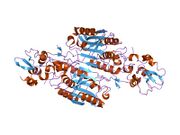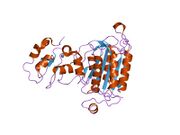Biology:XIAP
 Generic protein structure example |
X-linked inhibitor of apoptosis protein (XIAP), also known as inhibitor of apoptosis protein 3 (IAP3) and baculoviral IAP repeat-containing protein 4 (BIRC4), is a protein that stops apoptotic cell death. In humans, this protein (XIAP) is produced by a gene named XIAP gene located on the X chromosome.[1][2]
XIAP is a member of the inhibitor of apoptosis family of proteins (IAP). IAPs were initially identified in baculoviruses, but XIAP is one of the homologous proteins found in mammals.[3] It is so called because it was first discovered by a 273 base pair site on the X chromosome.[1] The protein is also called human IAP-like Protein (hILP), because it is not as well conserved as the human IAPS: hIAP-1 and hIAP-2.[1][4] XIAP is the most potent human IAP protein currently identified.[5]
Discovery
Neuronal apoptosis inhibitor protein (NAIP) was the first homolog to baculoviral IAPs that was identified in humans.[1] With the sequencing data of NIAP, the gene sequence for a RING zinc-finger domain was discovered at site Xq24-25.[1] Using PCR and cloning, three BIR domains and a RING finger were found on the protein, which became known as X-linked Inhibitor of Apoptosis Protein. The transcript size of Xiap is 9.0kb, with an open reading frame of 1.8kb.[1] Xiap mRNA has been observed in all human adult and fetal tissues "except peripheral blood leukocytes".[1] The XIAP sequences led to the discovery of other members of the IAP family.
Structure
XIAP consists of three major types of structural elements (domains). Firstly, there is the baculoviral IAP repeat (BIR) domain consisting of approximately 70 amino acids, which characterizes all IAP.[5] Secondly, there is a UBA domain, which allows XIAP to bind to ubiquitin. Thirdly, there is a zinc-binding domain, or a "carboxy-terminal RING Finger".[4] XIAP has been characterized with three amino-terminal BIR domains followed by one UBA domain and finally one RING domain.[6] Between the BIR-1 and BIR-2 domains, there is a linker-BIR-2 region that is thought to contain the only element that comes into contact with the caspase molecule to form the XIAP/Caspase-7 complex.[7] In solution the full length form of XIAP forms a homodimer of approximately 114 kDa.[8]
Function
XIAP stops apoptotic cell death that is induced either by viral infection or by overproduction of caspases. Caspases are the enzymes primarily responsible for cell death.[4] XIAP binds to and inhibits caspase 3, 7 and 9.[9] The BIR2 domain of XIAP inhibits caspase 3 and 7, while BIR3 binds to and inhibits caspase 9.[5] The RING domain utilizes E3 ubiquitin ligase activity and enables IAPs to catalyze ubiquination of self, caspase-3, or caspase-7 by degradation via proteasome activity.[10] However, mutations affecting the RING Finger do not significantly affect apoptosis, indicating that the BIR domain is sufficient for the protein's function.[4] When inhibiting caspase-3 and caspase-7 activity, the BIR2 domain of XIAP binds to the active-site substrate groove, blocking access of the normal protein substrate that would result in apoptosis.[10][11]
Caspases are activated by cytochrome c, which is released into the cytosol by dysfunctioning mitochondria.[4] Studies show that XIAP does not directly affect cytochrome c.[4]
XIAP distinguishes itself from the other human IAPs because it is able to effectively prevent cell death due to "TNF-α, Fas, UV light, and genotoxic agents".[4]
Inhibiting XIAP
XIAP is inhibited by DIABLO (Smac) and HTRA2 (Omi), two death-signaling proteins released into the cytoplasm by the mitochondria.[6] Smac/DIABLO, a mitochondrial protein and negative regulator of XIAP, can enhance apoptosis by binding to XIAP and preventing it from binding to caspases. This allows normal caspase activity to proceed. The binding process of Smac/DIABLO to XIAP and caspase release requires a conserved tetrapeptide motif.[10]
Clinical significance
Deregulation of XIAP can result in "cancer, neurodegenerative disorders, and autoimmunity".[6] High proportions of XIAP may function as a tumor marker.[5] In the development of lung cancer NCI-H460, the overexpression of XIAP not only inhibits caspase, but also stops the activity of cytochrome c (Apoptosis). In developing prostate cancer, XIAP is one of four IAPs overexpressed in the prostatic epithelium, indicating that a molecule that inhibits all IAPs may be necessary for effective treatment.[12] Apoptotic regulation is an extremely important biological function, as evidenced by "the conservation of the IAPs from humans to Drosophila".[1]
Mutations in the XIAP gene can result in a severe and rare type of inflammatory bowel disease.[13] Defects in the XIAP gene can also result in an extremely rare condition called X-linked lymphoproliferative disease type 2.[13][14][15]
Interactions
XIAP has been shown to interact with:
- ALS2CR2,[16]
- Caspase 3.[17][18][9][19][20][21]
- Caspase 7,[17][18][9][19]
- Caspase-9,[22][23][24][25]
- Diablo homolog[23][26][27][28][29]
- HtrA serine peptidase 2,[26][30]
- MAGED1,[31]
- MAP3K2,[32]
- TAB1,[16][33] and
- XAF1.[34]
References
- ↑ 1.0 1.1 1.2 1.3 1.4 1.5 1.6 1.7 "Suppression of apoptosis in mammalian cells by NAIP and a related family of IAP genes". Nature 379 (6563): 349–53. January 1996. doi:10.1038/379349a0. PMID 8552191. Bibcode: 1996Natur.379..349L.
- ↑ "A conserved family of cellular genes related to the baculovirus iap gene and encoding apoptosis inhibitors". The EMBO Journal 15 (11): 2685–94. June 1996. doi:10.1002/j.1460-2075.1996.tb00629.x. PMID 8654366.
- ↑ "Functional characterization of the X-linked inhibitor of apoptosis (XIAP) internal ribosome entry site element: role of La autoantigen in XIAP translation". Molecular and Cellular Biology 20 (13): 4648–57. July 2000. doi:10.1128/MCB.20.13.4648-4657.2000. PMID 10848591.
- ↑ 4.0 4.1 4.2 4.3 4.4 4.5 4.6 "Human IAP-like protein regulates programmed cell death downstream of Bcl-xL and cytochrome c". Molecular and Cellular Biology 18 (1): 608–15. January 1998. doi:10.1128/MCB.18.1.608. PMID 9418907.
- ↑ 5.0 5.1 5.2 5.3 "IAP family proteins--suppressors of apoptosis". Genes & Development 13 (3): 239–52. February 1999. doi:10.1101/gad.13.3.239. PMID 9990849.
- ↑ 6.0 6.1 6.2 "Upstream regulatory role for XIAP in receptor-mediated apoptosis". Molecular and Cellular Biology 24 (16): 7003–14. August 2004. doi:10.1128/MCB.24.16.7003-7014.2004. PMID 15282301.
- ↑ "Structural basis of caspase inhibition by XIAP: differential roles of the linker versus the BIR domain". Cell 104 (5): 781–90. March 2001. doi:10.1016/S0092-8674(01)00273-2. PMID 11257231.
- ↑ "Conformational characterization of full-length X-chromosome-linked inhibitor of apoptosis protein (XIAP) through an integrated approach". IUCrJ 6 (Pt 5): 948–957. September 2019. doi:10.1107/S205225251901073X. PMID 31576227.
- ↑ 9.0 9.1 9.2 "X-linked IAP is a direct inhibitor of cell-death proteases". Nature 388 (6639): 300–4. July 1997. doi:10.1038/40901. PMID 9230442. Bibcode: 1997Natur.388..300D.
- ↑ 10.0 10.1 10.2 Gewies A (2003). "Introduction to Apoptosis". CellDeath.de. http://www.celldeath.de/encyclo/aporev/apointro.pdf.
- ↑ "Human inhibitor of apoptosis proteins: why XIAP is the black sheep of the family". EMBO Reports 7 (10): 988–94. October 2006. doi:10.1038/sj.embor.7400795. PMID 17016456.
- ↑ "Targeting apoptosis in prostate cancer: focus on caspases and inhibitors of apoptosis proteins". BJU International 96 (Suppl 2): 30–4. December 2005. doi:10.1111/j.1464-410X.2005.05944.x. PMID 16359436.
- ↑ 13.0 13.1 "Making a definitive diagnosis: successful clinical application of whole exome sequencing in a child with intractable inflammatory bowel disease". Genetics in Medicine 13 (3): 255–62. March 2011. doi:10.1097/GIM.0b013e3182088158. PMID 21173700.
- Mark Johnson; Kathleen Gallagher (December 18, 2010). "State team publishes trailblazing DNA work". Milwaukee Journal Sentinel. http://www.jsonline.com/features/health/112114619.html.
- ↑ "OMIM Entry - # 300635 - LYMPHOPROLIFERATIVE SYNDROME, X-LINKED, 2; XLP2" (in en-us). https://omim.org/entry/300635.
- ↑ "XIAP deficiency in humans causes an X-linked lymphoproliferative syndrome". Nature 444 (7115): 110–4. November 2006. doi:10.1038/nature05257. PMID 17080092. Bibcode: 2006Natur.444..110R.
- ↑ 16.0 16.1 "ILPIP, a novel anti-apoptotic protein that enhances XIAP-mediated activation of JNK1 and protection against apoptosis". The Journal of Biological Chemistry 277 (34): 30454–62. August 2002. doi:10.1074/jbc.M203312200. PMID 12048196.
- ↑ 17.0 17.1 "Structural basis for the inhibition of caspase-3 by XIAP". Cell 104 (5): 791–800. March 2001. doi:10.1016/S0092-8674(01)00274-4. PMID 11257232.
- ↑ 18.0 18.1 "The c-IAP-1 and c-IAP-2 proteins are direct inhibitors of specific caspases". The EMBO Journal 16 (23): 6914–25. December 1997. doi:10.1093/emboj/16.23.6914. PMID 9384571.
- ↑ 19.0 19.1 "X-linked inhibitor of apoptosis protein (XIAP) inhibits caspase-3 and -7 in distinct modes". The Journal of Biological Chemistry 276 (29): 27058–63. July 2001. doi:10.1074/jbc.M102415200. PMID 11359776.
- ↑ "Ubiquitin-protein ligase activity of X-linked inhibitor of apoptosis protein promotes proteasomal degradation of caspase-3 and enhances its anti-apoptotic effect in Fas-induced cell death". Proceedings of the National Academy of Sciences of the United States of America 98 (15): 8662–7. July 2001. doi:10.1073/pnas.161506698. PMID 11447297. Bibcode: 2001PNAS...98.8662S.
- ↑ "The anti-apoptotic activity of XIAP is retained upon mutation of both the caspase 3- and caspase 9-interacting sites". The Journal of Cell Biology 157 (1): 115–24. April 2002. doi:10.1083/jcb.200108085. PMID 11927604.
- ↑ "Towards a proteome-scale map of the human protein-protein interaction network". Nature 437 (7062): 1173–8. October 2005. doi:10.1038/nature04209. PMID 16189514. Bibcode: 2005Natur.437.1173R.
- ↑ 23.0 23.1 "Neuronal apoptosis-inhibitory protein does not interact with Smac and requires ATP to bind caspase-9". The Journal of Biological Chemistry 279 (39): 40622–8. September 2004. doi:10.1074/jbc.M405963200. PMID 15280366.
- ↑ "IAPs block apoptotic events induced by caspase-8 and cytochrome c by direct inhibition of distinct caspases". The EMBO Journal 17 (8): 2215–23. April 1998. doi:10.1093/emboj/17.8.2215. PMID 9545235.
- ↑ "Molecular cloning of ILP-2, a novel member of the inhibitor of apoptosis protein family". Molecular and Cellular Biology 21 (13): 4292–301. July 2001. doi:10.1128/MCB.21.13.4292-4301.2001. PMID 11390657.
- ↑ 26.0 26.1 "HtrA2 promotes cell death through its serine protease activity and its ability to antagonize inhibitor of apoptosis proteins". The Journal of Biological Chemistry 277 (1): 445–54. January 2002. doi:10.1074/jbc.M109891200. PMID 11604410.
- ↑ "A novel ubiquitin fusion system bypasses the mitochondria and generates biologically active Smac/DIABLO". The Journal of Biological Chemistry 278 (9): 7494–9. February 2003. doi:10.1074/jbc.C200695200. PMID 12511567.
- ↑ "Direct interaction between survivin and Smac/DIABLO is essential for the anti-apoptotic activity of survivin during taxol-induced apoptosis". The Journal of Biological Chemistry 278 (25): 23130–40. June 2003. doi:10.1074/jbc.M300957200. PMID 12660240.
- ↑ "Identification of DIABLO, a mammalian protein that promotes apoptosis by binding to and antagonizing IAP proteins". Cell 102 (1): 43–53. July 2000. doi:10.1016/S0092-8674(00)00009-X. PMID 10929712.
- ↑ "The polypeptide chain-releasing factor GSPT1/eRF3 is proteolytically processed into an IAP-binding protein". The Journal of Biological Chemistry 278 (40): 38699–706. October 2003. doi:10.1074/jbc.M303179200. PMID 12865429.
- ↑ "Neurotrophin receptor-interacting mage homologue is an inducible inhibitor of apoptosis protein-interacting protein that augments cell death". The Journal of Biological Chemistry 276 (43): 39985–9. October 2001. doi:10.1074/jbc.C100171200. PMID 11546791.
- ↑ "XIAP regulates bi-phasic NF-kappaB induction involving physical interaction and ubiquitination of MEKK2". Cellular Signalling 20 (11): 2107–12. November 2008. doi:10.1016/j.cellsig.2008.08.004. PMID 18761086.
- ↑ "XIAP, a cellular member of the inhibitor of apoptosis protein family, links the receptors to TAB1-TAK1 in the BMP signaling pathway". The EMBO Journal 18 (1): 179–87. January 1999. doi:10.1093/emboj/18.1.179. PMID 9878061.
- ↑ "Identification of XAF1 as an antagonist of XIAP anti-Caspase activity". Nature Cell Biology 3 (2): 128–33. February 2001. doi:10.1038/35055027. PMID 11175744.
Further reading
- "Application of XIAP antisense to cancer and other proliferative disorders: development of AEG35156/ GEM640". Annals of the New York Academy of Sciences 1058 (1): 215–34. November 2005. doi:10.1196/annals.1359.032. PMID 16394139. Bibcode: 2005NYASA1058..215L.
- "Human inhibitor of apoptosis proteins: why XIAP is the black sheep of the family". EMBO Reports 7 (10): 988–94. October 2006. doi:10.1038/sj.embor.7400795. PMID 17016456.
External links
 |














